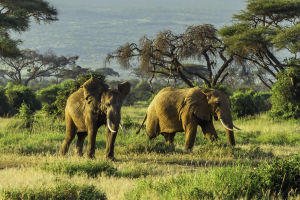In the animal kingdom, tails serve a multitude of purposes, from aiding in locomotion to communication and survival.
For marine animals like whales and sharks, tails are essential for movement, while land animals use them for balance, climbing, or even swatting away insects. Birds rely on their tail feathers for flight, while others, like dogs and wolves, use tails as part of social interaction.
Tails come in all shapes and sizes—furry, finned, feathered, short, or extremely long. Today, Lykkers, let's explore 12 animals known for their extraordinarily long tails, which range from elegant tools of attraction to survival essentials.
1. Giraffes
- Why It’s Special?: Renowned for their height, giraffes also boast impressive tails that measure about 2.4 meters (8 feet) long. These tails act as natural flyswatters, helping to shoo away pesky insects.
- Fun Fact: Giraffe subspecies are under threat due to poaching, with their tails and other body parts sought for illegal trade.
2. Long-Eared Jerboas
- Why It’s Special?: These small, mouse-like rodents have tails nearly double their body length! Their thin tails measure up to 16.2 cm (6.4 inches), adorned with tufts of fur at the tip.
- Where to Spot Them?: Southern Mongolia and northwestern China are home to this fascinating creature with its kangaroo-like jumping ability.
3. Blue Whales
- Why It’s Special?: As the largest animals ever to roam the Earth, blue whales have tails—or flukes—up to 7.5 meters (25 feet) wide.
- Body Proportions: These majestic creatures measure about 30 meters (100 feet) in length overall.
- Conservation Alert: Human activities like ocean noise pollution and vessel strikes threaten blue whales, despite their colossal size.
4. Long-Tailed Widowbirds
- Why It’s Special?: Male widowbirds flaunt tails that measure up to 20 cm (7.9 inches), making up nearly 30% of their total body length. These tails are used to attract mates, even though they hinder flight.
- Habitat: They are native to sub-Saharan Africa.
5. Long-Tailed Grass Lizards
- Why It’s Special?: These tiny reptiles have tails up to three times their body length, reaching about 60 cm (24 inches). Their prehensile tails help them climb and escape predators by detaching when threatened.
- Where to Find Them?: Southeast Asia.
6. Angolan Colobus Monkeys
- Why It’s Special?: These arboreal primates have tails that can grow longer than their bodies, aiding them in balancing and leaping between trees. Male tails measure about 84 cm (33 inches).
- Range: Sub-Saharan Africa.
7. Whiptail Stingrays
- Why It’s Special?: These rays have tails up to three times their body length, often used as whips equipped with venomous barbs for defense and hunting.
- Habitat: Found in tropical and temperate waters.
8. Slender Glass Lizards
- Why It’s Special?: Often mistaken for snakes, these legless lizards have tails that are much longer than their bodies, with tail lengths reaching 35.1 cm (13.8 inches).
- Distinctive Features: Unlike snakes, they possess eyelids and external ears.
9. Ring-Tailed Lemurs
- Why It’s Special?: Native to Madagascar, these lemurs use their black-and-white striped tails, which measure up to 61 cm (2 feet), for balance and communication.
- Fun Fact: They raise their tails above tall grass to signal their location to others.
10. Spider Monkeys
- Why It’s Special?: These acrobatic primates have prehensile tails up to 34 inches long, which they use as a fifth limb for climbing and swinging through trees.
- Range: Found in the forests of Central and South America.
11. Thresher Sharks
- Why It’s Special?: Known for their long, whip-like tails, thresher sharks’ tails account for about half their body length, measuring up to 3 meters (10 feet).
- Use of Tails: Their tails are not just for show; they use them to stun prey while hunting.
12. Ribbon-Tailed Astrapias
- Why It’s Special?: The males of this bird-of-paradise species, native to Papua New Guinea, have tails three times their body length, growing up to 1 meter (3 feet) long.
- Purpose: These extravagant tails are purely ornamental, helping males attract mates.
From the arboreal grace of spider monkeys to the oceanic might of blue whales, the animal kingdom’s longest tails are as diverse as they are fascinating.
They serve purposes ranging from survival to reproduction, offering a glimpse into nature’s incredible adaptability. So, which one of these tailed wonders impressed you the most? Let us know—until next time, keep exploring!
Animal Size Comparison | 3d Animation Comparison | Real Scale Comparison
Video by Global Data


